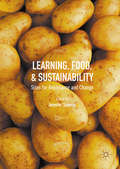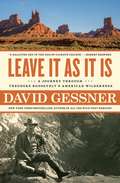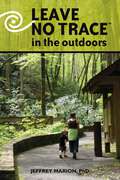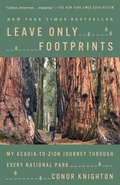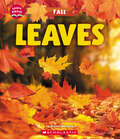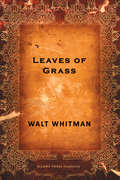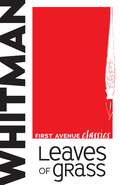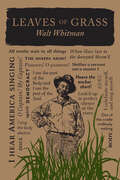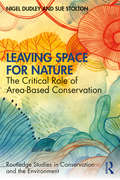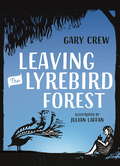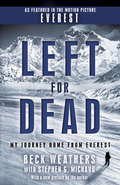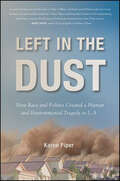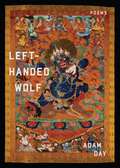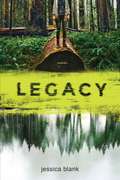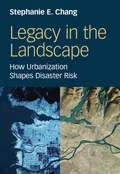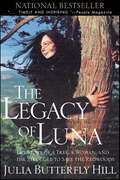- Table View
- List View
Learning, Food, and Sustainability
by Jennifer SumnerThis edited volume explores the intersection of learning and food, both within and beyond the classroom, all within the context of sustainability. Taking a broad pedagogical approach to the question of food, it focuses on learning and change in a number of key sites including schools, homes, communities, and social movements, keeping in mind that we need to learn our way out of our current unsustainable food system and in to more sustainable alternatives.
Leather Art: Molding, Shaping, and Color Techniques to Take Your Work Beyond the Ordinary
by Cathy WigginsA popular designer teaches 18 projects to help turn your basic leather creations into head-turning artistic statementsFor leather crafters who don't need more patterns but instead want to add artistic impact to their workWiggins's leather art is found in high-end homes, museums, and even Las Vegas hotel casinos
Leatherback Blues: The Wild Place Adventure Series (The\wild Place Adventure Ser. #4)
by Karen Hood-CaddyRobin is kidnapped by dangerous poachers while trying to save leatherback turtles in Central America. Robin Green is carrying on her work rescuing vulnerable animals at The Wild Place Animal Shelter when she and Zo-Zo get an amazing chance to help protect sea turtles in Central America. Worried about the bugs, the heat, and the threat of poachers, Robin faces her fears and travels there with Zo-Zo, her brother, Squirm, and her eccentric grandmother, Griff. It only takes one scorpion sting before Robin wants to go home, but the unbelievable sight of a leatherback turtle laying eggs on the beach changes her mind. Just when the group starts making progress, the poachers strike back. Suddenly, the turtles aren’t the only ones who need rescuing! Can Robin and Zo-Zo find a way out?
Leave It As It Is: A Journey Through Theodore Roosevelt's American Wilderness
by David GessnerBestselling author David Gessner&’s wilderness road trip inspired by America&’s greatest conservationist, Theodore Roosevelt, is &“a rallying cry in the age of climate change&” (Robert Redford).&“Leave it as it is,&” Theodore Roosevelt announced while viewing the Grand Canyon for the first time. &“The ages have been at work on it and man can only mar it.&” Roosevelt&’s pronouncement signaled the beginning of an environmental fight that still wages today. To reconnect with the American wilderness and with the president who courageously protected it, acclaimed nature writer and New York Times bestselling author David Gessner embarks on a great American road trip guided by Roosevelt&’s crusading environmental legacy. Gessner travels to the Dakota badlands where Roosevelt awakened as a naturalist; to Yellowstone, Yosemite, and the Grand Canyon where Roosevelt escaped during the grind of his reelection tour; and finally, to Bears Ears, Utah, a monument proposed by Native Tribes that is currently embroiled in a national conservation fight. Along the way, Gessner questions and reimagines Roosevelt&’s vision for today&’s lands. &“Insightful, observant, and wry,&” (BookPage) Leave It As It Is offers an arresting history of Roosevelt&’s pioneering conservationism, a powerful call to arms, and a profound meditation on our environmental future.
Leave No Trace in the Outdoors
by Jeffrey L. MarionThe essential guide for enjoying the outdoors without harming the environment. <p><p>• Details the seven core principles of Leave No Trace ethics and practices <p>• Covers hiking, campfires, food storage, and personal hygiene <p>• Endorsed by the USDI National Park Service, Bureau of Land Management, Fish and Wildlife Service, U.S. Geological Survey, and the USDA Forest Service
Leave No Trace in the Outdoors
by Jeffrey MarionThe essential guide for enjoying the outdoors without harming the environment.
Leave Only Footprints: My Acadia-to-Zion Journey Through Every National Park
by Conor Knighton<P><P>From CBS Sunday Morning correspondent Conor Knighton, a behind-the-scenery look at his year traveling to each of America's National Parks, discovering the most beautiful places and most interesting people our country has to offerWhen Conor Knighton set off to explore America's "best idea," he worried the whole thing could end up being his worst idea. <P><P>A broken engagement and a broken heart had left him longing for a change of scenery, but the plan he'd cooked up in response had gone a bit overboard in that department: Over the course of a single year, Knighton would visit every national park in the country, from Acadia to Zion. In Leave Only Footprints, Knighton shares informative and entertaining dispatches from what turned out to be the road trip of a lifetime. Whether he's waking up early for a naked scrub in a historic bathhouse in Arkansas or staying up late to stargaze along our loneliest highway in Nevada, Knighton weaves together the type of stories you're not likely to find in any guidebook. <P><P>Through his unique lens, America the Beautiful becomes America the Captivating, the Hilarious, and the Inspiring. Along the way, he identifies the threads that tie these wildly different places together—and that tie us to nature—and reveals how his trip ended up changing his views on everything from God and love to politics and technology. Filled with fascinating tidbits about our parks' past and reflections on their fragile future, this book is both a celebration of and a passionate case for the natural wonders that all Americans share. <P><P><b>A New York Times Bestseller</b>
Leave a Message in the Sand: Poems about Giraffes, Bongos, and Other Creatures with Hooves
by Bibi Dumon TakWhat would a boar text to a pig, a camel post on a dating site, or a goat shout from the mountaintops? In this unforgettable poetry collection, even-toed ungulates take the spotlight. Ever asked a giraffe about the clouds, read an okapi&’s letter to the editor, or debated which gnu would win the race across the Serengeti? Playful poems and whimsical illustrations feature hoofed creatures from all around the world, from Siberian musk deer to African dik-diks to South American vicuñas. Weaving together humor, scientific detail, and a poignant concern for conservation, Leave a Message in the Sand introduces readers to wild creatures with even wilder things to say.
Leaves (Learn About)
by Brenna MaloneyLet's learn all about the most important symbols and celebrations of the fall season!Red, orange, yellow... even purple! In Fall, trees exploding with colorful leaves are one of nature's most beautiful sights. With vibrant photos and lively text, this book explores what leaves do for nature, as well as how and why leaves change. Get ready to learn all about leaves in fall!ABOUT THE SERIES:Fall is here and so are colorful leaves, delicious apples, orange pumpkins, and lots of celebrations! With this new series, dive into the icons that make fall so much fun. Why do we harvest apples in fall? How does a pumpkin grow? Why do leaves change color? What holidays are in fall? With gorgeous photographs and simple text, this is a celebratory exploration of the fall season.
Leaves of Grass
by Walt WhitmanOriginally published as a collection of twelve poems in 1855, Leaves of Grass eventually grew to more than four hundred poems, as Walt Whitman continued to edit and add to the collection throughout his life.Celebrating life, humanity, and the material world, Leaves of Grass was considered obscene at the time of its publication because of its overt discussion of sensual pleasure. It is now considered to be among the greatest collections of poetry to be published in modern times.Be it mystery, romance, drama, comedy, politics, or history, great literature stands the test of time. ClassicJoe proudly brings literary classics to today's digital readers, connecting those who love to read with authors whose work continues to get people talking. Look for other fiction and non-fiction classics from ClassicJoe.
Leaves of Grass: 1st Edition 1855 (First Avenue Classics ™)
by Walt WhitmanIn Leaves of Grass, American poet Walt Whitman assembled most of his poetic works. Included in this collection are some of Whitman's most famous poems, including "Song of Myself," "I Sing the Body Electric," "Out of the Cradle Endlessly Rocking," and "O Captain! My Captain!" The first edition of Leaves of Grass was published in 1855 and contained only twelve poems. Whitman kept revising his collection throughout his life; the final edition contains more than three hundred poems. This is an unabridged version of the poems from the final edition of Whitman's celebrated collection, published shortly before his death in 1892.
Leaves of Grass: Including A Fac-simile Autobiography, Variorum Readings Of The Poems And A Department Of Gathered Leaves... - Primary Source Edition (Vintage Classics #Vol. No. 9)
by Walt WhitmanAbraham Lincoln read it with approval, but Emily Dickinson described its bold language and themes as "disgraceful." Ralph Waldo Emerson found it "the most extraordinary piece of wit and wisdom that America has yet produced." Published at the author's expense on July 4, 1855, Leaves of Grass inaugurated a new voice and style into American letters and gave expression to an optimistic, bombastic vision that took the nation as its subject. Unlike many other editions of Leaves of Grass, which reproduce various short, early versions, this Modern Library Paperback Classics "Death-bed" edition presents everything Whitman wrote in its final form, and includes newly commissioned notes.
Leaves of Grass: The Poems Of Walt Whitman (Word Cloud Classics)
by Walt WhitmanA seminal event in American literature, this nineteenth-century collection of poetry and essays celebrates nature and humanity&’s place in it.Leaves of Grass is a timeless collection of poems and essays penned by influential nineteenth-century writer Walt Whitman. This profound compilation explores topics such as nature, mysticism, mortality, transcendentalism, and democracy. Inspired by personal experiences and observations, Whitman spent almost four decades piecing together the complete work, sharing societal ideals and epiphanies about life that still resonate with readers today.
Leaving Space for Nature: The Critical Role of Area-Based Conservation (Routledge Studies in Conservation and the Environment)
by Nigel Dudley Sue StoltonThis book provides the first contemporary assessment of area-based conservation and its implications for nature and society. Now covering 15 per cent of the land surface and a growing area of ocean, the creation of protected areas is one of the fastest conscious changes in land management in history. But this has come at a cost, including a backlash from human rights organisations about the social impacts of protected areas. At the same time, a range of new types of area-based conservation has emerged, based on indigenous people’s territories, local community lands and a new designation of “other effective area-based conservation measures”. This book provides a concise overview of the status and possible futures of area-based conservation. With many people calling for half the earth’s land surface to remain in a natural condition, this book taps into the urgent debate about the feasibility of such an aim and the ways in which such land might be managed. It provides a timely contribution by people who have been at the centre of the debate for the last twenty years. Building on the authors’ large personal knowledge, the book draws on global case studies where the authors have firsthand experience, including Yosemite National Park (USA), Blue Mountains National Park (Australia), Bwindi National Park (Uganda), Chingaza National Park (Colombia), Ustyart Plateau (Kazakhstan), Snowdonia National Park (Wales) and many more. This book is essential reading for students, academics and practitioners interested in conservation and its impact on society.
Leaving the Lyrebird Forest
by Gary Crew Julian Laffan'Are you lonely here?' her mother asked. 'Never,' Alice said. 'Not while I am friends with the lyrebird.'Alice has spent her life living on the outskirts of a small town, in a house nestled in bushland. Every other morning, she is visited by a lyrebird. Her bond with this magnificent bird brings her together with her nearest neighbour, Mr Brown, a widower who loves the bush and its treasures as much as she does.But change is coming: Alice is growing up, and having to think about her future (a future which might mean leaving the bush for her education). Mr Brown is getting older, and less able to look after himself. And as the nearby town grows, their beloved lyrebird and bushland are threatened too.A touching story that will resonate with readers everywhere, stunningly illustrated with woodcuts by acclaimed artist Julian Laffan.
Leben bleibt rätselhaft: Was wissen wir über die großen Fragen der Biologie?
by Andreas JahnDie ungeklärten Mysterien der BiologieWoher kommt das Leben? Warum schlafen wir? Wie können wir länger leben? Drei von sechs grundlegenden Fragen, die immer noch weitgehend offen sind und mit denen sich die moderne Biologie beschäftigt. Zu den ungelösten Mysterien zählen außerdem Evolution, Vererbung und Bewusstsein. Wie namhafte Wissenschaftler aus aller Welt versuchen, der Natur diese Geheimnisse Stück für Stück zu entlocken, beschreibt dieses Buch anhand ausgewählter Artikel aus den Zeitschriften "Spektrum der Wissenschaft" und "Gehirn&Geist". Meist sind es die Forscher selbst, die aus erster Hand ihre Beobachtungen und Entdeckungen schildern und somit Gelegenheit geben, ihnen über die Schulter zu schauen. Dabei sind sie sich längst nicht in allen Punkten einig. Der vorliegende Sammelband spiegelt den aktuellen Wissensstand, aber auch die zum Teil kontroversen Ansichten über die Wunder des Lebens wider.
Lecture Notes on Resource and Environmental Economics (The Economics of Non-Market Goods and Resources #16)
by Anthony C. FisherThis book, based on lectures on natural and environmental resource economics, offers a nontechnical exposition of the modern theory of sustainability in the presence of resource scarcity. It applies an alternative take on environmental economics, focusing on the economics of the natural environment, including development, computation, and potential empirical importance of the concept of option value, as opposed to the standard treatment of the economics of pollution control. The approach throughout is primarily conceptual and theoretical, though empirical estimation and results are sometimes noted. Mathematics, ranging from elementary calculus to more formal dynamic optimization, is used, especially in the early chapters on the optimal management of exhaustible and renewable resources, but results are always given an economic interpretation. Diagrams and numerical examples are also used extensively.The first chapter introduces the classical economists as the first resource economists, in their discussion of the implications of a limited natural resource base (agricultural land) for the evolution of the wider economy. A later chapter returns to the same concerns, along with others stimulated by the energy and environmental “crises” of the 1970s and beyond. One section considers alternative measures of resource scarcity and empirical findings on their behavior over time. Another introduces the modern concept of sustainability with an intuitive development of the analytics. A chapter on the dynamics of environmental management motivates the concept of option value, shows how to compute it, then demonstrates its importance in an illustrative empirical example. The closing chapter, on climate change, first projects future changes and potential catastrophic impacts, then discusses the policy relevance of both option value and discounting for the very long run.This book is intended for resource and environmental economists and can be read by interested graduate and advanced undergraduate students in the field as well.
Ledger: Poems
by Jane HirshfieldA pivotal book of personal, ecological, and political reckoning from the internationally renowned poet named "among the modern masters" (The Washington Post).Ledger's pages hold the most important and masterly work yet by Jane Hirshfield, one of our most celebrated contemporary poets. From the already much-quoted opening lines of despair and defiance ("Let them not say: we did not see it. / We saw"), Hirshfield's poems inscribe a registry, both personal and communal, of our present-day predicaments. They call us to deepened dimensions of thought, feeling, and action. They summon our responsibility to sustain one another and the earth while pondering, acutely and tenderly, the crises of refugees, justice, and climate. They consider "the minimum mass for a whale, for a language, an ice cap," recognize the intimacies of connection, and meditate upon doubt and contentment, a library book with previously dog-eared corners, the hunger for surprise, and the debt we owe this world's continuing beauty. Hirshfield's signature alloy of fact and imagination, clarity and mystery, inquiry, observation, and embodied emotion has created a book of indispensable poems, tuned toward issues of consequence to all who share this world's current and future fate.
Left for Dead: My Journey Home from Everest
by Beck WeathersI am neither churchly nor a particularly spiritual person, but I can tell you that some force within me rejected death at the last moment and then guided me, blind and stumbling--quite literally a dead man walking--into camp and the shaky start of my return to life. On May 10, 1996, nine climbers perished in a blizzard high on Mount Everest, the single deadliest day ever on the peak. The following day, one of those victims was given a second chance. His name was Beck Weathers.The tale of Dr. Seaborn Beck Weathers's miraculous awakening from a deep hypothermic coma was widely reported. But the hidden story of what led the pathologist to Everest in the first place, and his painful recovery after his dramatic rescue, has not been told until now. Brilliant and gregarious, Weathers discovered in his thirties that mountain climbing helped him cope with the black dog of depression that had shadowed him since college. But the self-prescribed therapy came at a steep cost: estrangement from his wife, Peach, and their two children. By the time he embarked for Everest, his home life had all but disintegrated. Yet when he was reported dead after lying exposed on the mountain for eighteen hours in subzero weather, it was Peach who orchestrated the daring rescue that brought her husband home. Only then, facing months of surgery and the loss of his hands, did Beck Weathers also begin to face himself, his family, his past and uncertain future. Told in Beck Weathers's inimitably direct and engaging voice--with frequent commentary from Peach, their family, their friends and others involved in this unique journey--Left for Dead shows how one man's drive to conquer the most daunting physical challenges ultimately forced him to confront greater challenges within himself. Framed by breathtaking accounts of his near death and resurrection, and of his slow and agonizing physical and emotional recovery, Left for Dead offers a fascinating look at the seductive danger of extreme sports, as in rapid succession a seemingly unstoppable Weathers attacks McKinley, Elbrus, Aconcagua, Kilimanjaro--before fate stops him cold, high in the Death Zone of the world's tallest peak. Full of deep insight and warm humor, Left for Dead tells the story of a man, a marriage and a family that survived the unsurvivable. Candid and uncompromising, it is a deeply compelling saga of crisis and change, and of the abiding power of love and family--a story few readers will soon forget.
Left in the Dust: How Race and Politics Created a Human and Environmental Tragedy in L.A.
by Karen PiperAn intensely personal story crossed with a political potboiler, Left in the Dust is a unique and passionate account of the city of Los Angeles's creation, cover-up and inadequate attempts to repair a major environmental catastrophe. Owens River, which once fed Owens Lake, was diverted away from the lake to supply the faucets and sprinklers of Los Angeles. The dry lakebed now contains a dust saturated with toxic heavy metals, which are blown from the lake and inhaled by unsuspecting citizens throughout the Midwest, causing major health issues. Karen Piper, one of the victims who grew up breathing that dust, reveals the shocking truth behind this tragedy and examines how waste and pollution are often neglected to encourage urban growth, while poor, non-white, and rural areas are forgotten or sacrificed.
Left-Handed Wolf: Poems
by Adam DayAdam Day’s Left-Handed Wolf offers short lyrical meditations and narratives that wrestle with contemporary issues of the environment, spirituality, and the social. These compact, imagistic poems welcome space and silence as a way of addressing both the commonality and complexity of people and experience. Day’s poems—influenced by meditation practice, as well as by classical Japanese and Chinese verse—are serious and bawdy, reverential and impertinent, accessible and eclectic, yet unified in their tone, atmosphere, and sensibility.
Lefty Kreh's Solving Fly-Casting Problems
by Lefty KrehCasting a fly line is truly an art, and in Solving Fly- Casting Problems, Lefty Kreh shows how to get more distance, avoid tangles, and cast under conditions that would make fishing impossible for other anglers. Lefty begins with the fundamentals common to all good casts, and goes on to diagnose and eliminate a variety of casting problems, including how to: tame tailing loops, cast in windy conditions, change the direction of a cast quickly and accurately, get wet flies deeper and faster with a tuck cast, avoid trees and bushes behind the angler by throwing an extra-high backcast, skip the fly across water to reach under low-lying branches, and much more. Solving Fly-Casting Problems is written with the insight of a half century of teaching experience, and will be a great help to fly fishers at all skill levels.
Legacy
by Jessica BlankA powerful coming-of-age novel about a seventeen-year-old girl who joins a radical environmental movement in the Pacific Northwest.Ever since her older brother Andy died, Alison's life has been just as dark as her home in Tacoma, Washington. Her mom is in perpetual mourning, her father ran out on them, and after hanging out with Andy's hard-partying friends for a year, Alison's reputation is trashed. She planned on taking the path of least resistance during her senior year--hanging out with her punk rocker boyfriend and trying not to flunk out of school--until a massive fight with her mother pushes her over the edge, and she runs away. At first, joining a group of radical environmentalists who are occupying a Washington State forest is just about having a place to crash. But the ancient woods prove to be as vibrant and welcoming as they are vulnerable, and for the first time, Alison realizes that she might be more powerful than she thought. As tensions in the forest mount and confrontations with authorities get physical, Alison has to decide whether she's willing to put her own life on the line to fight for what she believes in. In this stunning literary work, Jessica Blank uses the anti-establishment and radical mood of the 1990s to show a girl grappling to find the strength and courage to do what's right . . . for the world . . . and for herself.
Legacy in the Landscape: How Urbanization Shapes Disaster Risk
by Stephanie E. ChangWith its focus on the city rather than the disaster event, this book situates natural disasters in the context of urban growth and change. It offers an original, interdisciplinary perspective by connecting the technical and socioeconomic dimensions of disaster risk and highlighting the commonalities of hazards such as river flooding, coastal flooding, and earthquakes. The book begins by proposing a novel Urban Risk Dynamics framework that emphasizes the roles of economy, landscape, and technology in influencing hazard, exposure, and vulnerability. This framework is then used to support the examination of six contrasting cities from around the world, offering generalized insights that apply to a wide range of urban risk contexts. The book will be of significant interest to students and researchers working in urban planning, civil engineering, Earth sciences, and environmental science, and to policy makers and practitioners concerned with reducing future disaster risk in cities.
Legacy of Luna: The Story of a Tree, a Woman, and the Struggle to Save the Redwoods
by Julia Butterfly HillOn December 18, 1999, Julia Butterfly Hill's feet touched the ground for the first time in over two years, as she descended from "Luna," a thousandyear-old redwood in Humboldt County, California.Hill had climbed 180 feet up into the tree high on a mountain on December 10, 1997, for what she thought would be a two- to three-week-long "tree-sit." The action was intended to stop Pacific Lumber, a division of the Maxxam Corporation, from the environmentally destructive process of clear-cutting the ancient redwood and the trees around it. The area immediately next to Luna had already been stripped and, because, as many believed, nothing was left to hold the soil to the mountain, a huge part of the hill had slid into the town of Stafford, wiping out many homes.Over the course of what turned into an historic civil action, Hill endured El Nino storms, helicopter harassment, a ten-day siege by company security guards, and the tremendous sorrow brought about by an old-growth forest's destruction. This story--written while she lived on a tiny platform eighteen stories off the ground--is one that only she can tell.Twenty-five-year-old Julia Butterfly Hill never planned to become what some have called her--the Rosa Parks of the environmental movement. Shenever expected to be honored as one of Good Housekeeping's "Most Admired Women of 1998" and George magazine's "20 Most Interesting Women in Politics," to be featured in People magazine's "25 Most Intriguing People of the Year" issue, or to receive hundreds of letters weekly from young people around the world. Indeed, when she first climbed into Luna, she had no way of knowing the harrowing weather conditions and the attacks on her and her cause. She had no idea of the loneliness she would face or that her feet wouldn't touch ground for more than two years. She couldn't predict the pain of being an eyewitness to the attempted destruction of one of the last ancient redwood forests in the world, nor could she anticipate the immeasurable strength she would gain or the life lessons she would learn from Luna. Although her brave vigil and indomitable spirit have made her a heroine in the eyes of many, Julia's story is a simple, heartening tale of love, conviction, and the profound courage she has summoned to fight for our earth's legacy.
